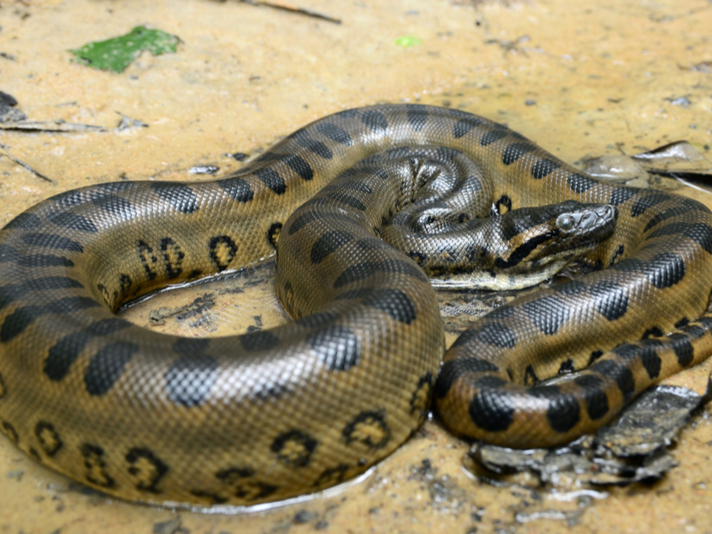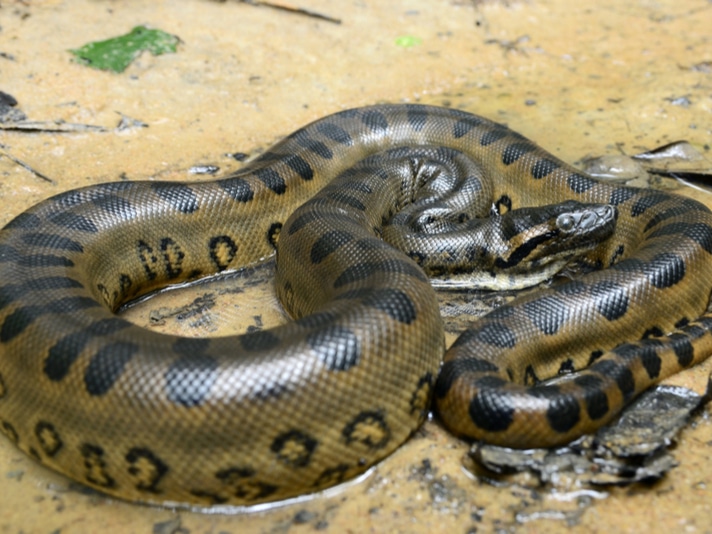Expert care tips for the green anaconda.
The anaconda has become more myth and legend than flesh and blood. Popular media have done an excellent job of glorifying and horrifying when it comes to Eunectes species. This article discusses the green anaconda (Eunectes murinus). Keeping this species of notorious folklore and herpetocultural fancy is nothing like what you see in the movies.

Patrick K. Campbell/Shutterstock
Large constricting snakes such as the green anaconda are for expert reptile keepers.
When anacondas first became available in the hobby, the majority were wild imports. Many of these animals had bad dispositions and parasites. It was all too common for them to fail to eat due to stress, illness and improper husbandry. A lack of knowledge at the time also precipitated high mortality rates.
Fortunately times have changed, and our hobby has evolved. Husbandry techniques have advanced tremendously and proper veterinary care has become more available to keepers who choose to offer it to their pets. Due to these changes, imported animals are established more successfully, and those already established are reproducing in captivity with greater success.
The Eunectes Four
Four species of semiaquatic South American boas go by the name of anaconda. One is the green anaconda (Eunectes murinus), which occurs in countries such as Brazil, Bolivia, Peru, Ecuador, French Guiana, Guyana, Colombia, Venezuela and the island of Trinidad. The yellow anaconda (E. notaeus) is the only other Eunectes species commonly seen in the pet trade. The dark-spotted anaconda (E. deschauenseei) is represented by more than 100 recorded animals. The Bolivian anaconda (E. beniensis) is a rare species averaging only 4 to 5 feet long.
Green Anacondas are not for Novices
Captive-bred anacondas can make calm, tractable pets when raised properly, but they do get large, and their strength should be respected. This is not a species for anyone under the age of 18 or for anyone who does not have a reasonable amount of experience working with large constrictors.
Captive-bred juvenile anacondas are an ideal choice. Juveniles have a greatly reduced probability of carrying parasites and foreign bacteria. Most importantly, they are the most likely individuals to become well-adjusted, content captives for a snakekeeper. Raising a juvenile increases a keeper’s knowledge of the animal’s full husbandry history, normal behavior, quirks and disposition. This often creates a more positive interaction for both the snakekeeper and the animal.
Want to Learn More?
18 Lawmakers Urge USFWS to Ban Boas, Retics, and Anacondas
Green Anacondas Can Grow More Than 14 Feet
The green anaconda is a gorgeous species with some variation of a military-green and semi-irregular dark circular dorsal blotches along the snake’s length. Some specimens express exceptional orange traditionally confined to the mandible, orbital scales and first third of the anterior. It can be very attractive.
This species does express consistent sexual dimorphism. Females are generally larger as adults, but adult size varies tremendously, and it is directly related to an individual’s genetic makeup, the quality of care it receives, and food availability. Males often average 7 to 9 feet when raised on a regimen of small prey items. However, when fed more frequently with larger prey items, captive males often reach 10 to 14 feet. Females average between 11 and 13 feet long. Averages aside, animals 50 percent larger than the sizes listed here have been reported.
Once an anaconda is more than 5 to 6 feet long, sexing can be done easily by examining the spurs. Males have noticeable ventral spurs, and females have an obvious absence of them.
Green Anaconda Enclosures With Water
Anaconda husbandry has various schools of thought. The traditional view is that a semiaquatic setup should be provided due to the anaconda’s affinity for an aquatic life. This is a noble concept, and if done properly, it would be a beautiful addition. But it’s not a decision to consider lightly. This is a labor-intensive setup. If you set out to create one, make sure you do your research.
The full scope of necessary considerations is difficult to discuss here, but I can provide some guidelines. You would need a terrarium measuring at least 6 feet long with land and water areas. The land area should take up two-thirds of the terrarium and be easy to keep clean. The ideal substrate is cypress mulch, but corrugated cardboard, some barks and even newspaper can work. A basking spot at one end is necessary, and you need enough space to properly achieve a temperature gradient. A tight fitting hide in which the snake can completely coil up is also beneficial.
A water basin would use the remaining one-third of this enclosure. It should provide enough room for the anaconda to fully submerge. The water temperature should be kept between 76 and 82 degrees Fahrenheit. The weight of the water and the potential for water damage to the land area also must be considered and addressed.
Water filtration is also an issue. Anacondas have large defecations, and the water basin can quickly become a cesspool. Mechanical and biological filtration is often necessary, and the system must be safely tucked away from the anaconda’s interest and weight. Use an undergravel filter to help with fecal matter and debris at the bottom.
Maintenance is another consideration. Stagnant water breeds bacteria, and water simply drained and refilled harbors and breeds bacteria. A septic bath in the enclosure is a recipe for a sick snake. Thus the water area has to be cleaned regularly with a gravel vacuum to remove debris. You also must carefully plan draining systems, so you can completely drain the basin and sanitize it on a regular basis.
A semiaquatic setup done properly is an ideal setup. Unfortunately, one done improperly can be one of the worst possible choices for an enclosure.
Green Anaconda Enclosure Without Water
Unfortunately, the practical application of a semiaquatic setup isn’t reasonable for most snakekeepers. A large, warm basin of water in an anaconda enclosure can quickly become a cesspool without vigilant cleaning and the best-of-the-best equipment.
An alternative housing option eliminates the pool, and it offers your pet a more sanitary and beneficial setup. It’s easier to clean and easier to remove the animal for cleaning, handling or veterinary care. There’s less stress on the snake that way, and the setup is more affordable.
A 10- to 20-gallon enclosure (or the equivalent) is a good setup for a juvenile. House adult males in a cage measuring 6 feet long, 3 feet wide and 11⁄2 feet tall, and house adult females in a cage measuring at least 8 feet long, 3 feet wide and 2 feet tall.
Cage furnishings are similar for juveniles and adults. Corrugated cardboard, newspaper, paper towels or 2- to 4-inch-deep cypress mulch are suitable substrates. Use a water bowl large enough to offer a clean water source but not big enough for the animal to soak because it may defecate in it. For young snakes an 8-ounce water bowl works well. Provide adults a bowl 1 foot in diameter. Also offer a tightfitting hide box with moist sphagnum moss or moist paper towels, and change them when soiled. Hides should be large enough for the snake to coil inside and touch all four walls without being too cramped.
Whether you have a juvenile or adult, the ambient temperature in the enclosure should be between 80 and 82 degrees. Also provide a hotspot between 88 to 92 degrees on one end. The most common items to achieve a hot spot are an incandescent heat bulb, a heating pad, heat tape, a ceramic heat emitter with a wire guard to prevent the animal from touching the fixture, or heat panels. Ultraviolet lighting is not required for anacondas, but providing it won’t harm the animal, and it benefits any plants in the cage.
Avoid a small nighttime drop until the animal is 2 to 3 years old. Juveniles are less hardy and lack an adult’s insulating body mass to handle the drop. Nighttime drops for adults should remain above 78 degrees on the cool end of the cage and above 84 degrees on the hot end.
Humidity is more important in an anaconda enclosure without a water area. Maintain the cage in 60 to 70 percent humidity with periodic spikes near 100 percent. Use caution; allow the humidity to lower to around 60 percent before creating another humidity spike.
Supplemental efforts to increase the ambient humidity may or may not be necessary. Use your best judgment; each situation is different. If you live in a humid environment, this may not be necessary. If you live somewhere arid, or if constant heating or air conditioning is being used, supplemental efforts are required. One way, if your snake is in a glass terrarium, is to adjust the screen top. Cover 25 to 75 percent of it with an acrylic sheet cut to fit on the inlay of the screen frame. This helps retain some humidity in the enclosure.
Although snakekeepers may like the look of an extravagant enclosure, the animal’s health benefits from a simple, sterile environment.
Feeding A Green Anaconda
Food items are often greedily taken by captive-bred or established wild-caught juveniles. Mice or rat pups (juvenile rats) work great as starter prey items. Offer one every seven days for the first 12 to 18 months. Gradually increase prey size as the animal grows. Food should be slightly smaller than the widest point of a snake’s diameter. Once the animal is around 4 feet long, slightly larger prey items (basically comparable to the widest point of the anaconda) can be offered every seven to 10 days. Adult males can be fed jumbo rats, guinea pigs or small rabbits every 10 to 14 days. Females thrive on a diet of medium to large rabbits every 10 to 14 days.
Keep an eye on your animal’s weight, and offer food accordingly. If an animal is preparing to breed or is recently back on a feeding regimen after a seasonal fast, increase the frequency of food offerings. However, exercise caution when increasing food quantity because overfeeding can lead to a variety of health issues. A good rule of thumb is to allow the lump in the snake’s midsection to disappear — generally three to six days depending on the size of the meal — before offering a second food item.
Always allow the animal to digest its meal for at least two to three days before you handle it. Handling a snake with a full stomach can cause regurgitation, which is extremely hard on your pet’s digestive tract.
Amazing Anacondas
One of the most impressive reptiles on this planet, green anacondas can make amazing captives. Unfortunately, this species faces legislation that may prevent it from being kept in captivity in the United States. If you decide to acquire any species of large constrictor, please buy the animal only after you’ve done your research, and be responsible with your pet once you’ve acquired it.
We are lucky to share our lives with these exotic and beautiful animals. To lose that right due to misinformation would be a sad sight to see. Together we can keep species such as the green anaconda thriving in captivity for our children and grandchildren to enjoy.
Jordan Russell has raised a variety of reptiles and birds throughout his life, and he has a special interest in arboreal boids and soft-bill birds.



